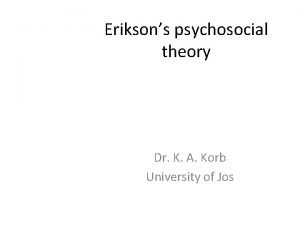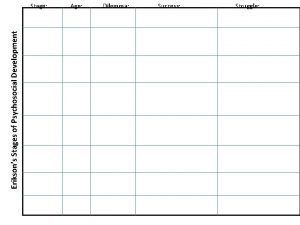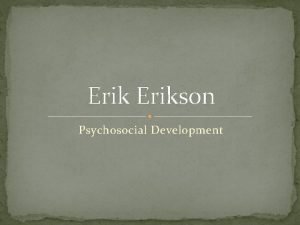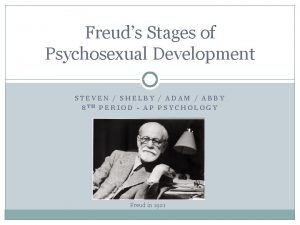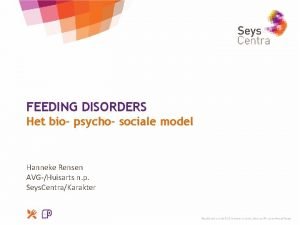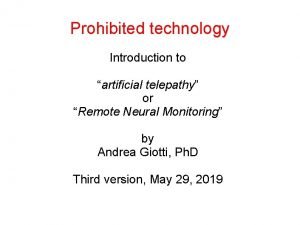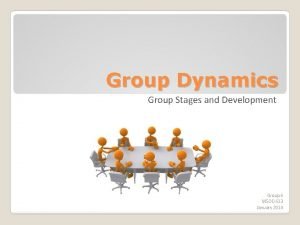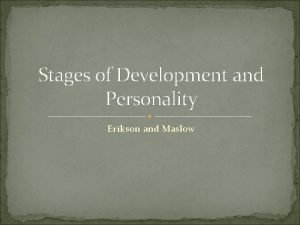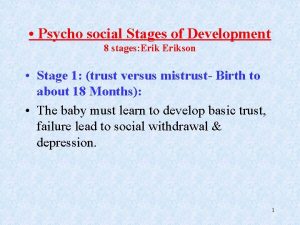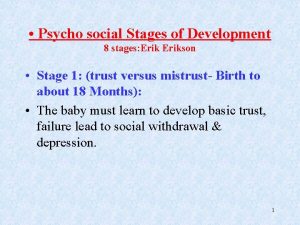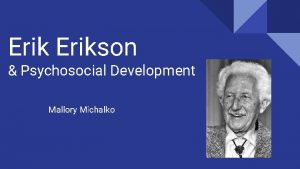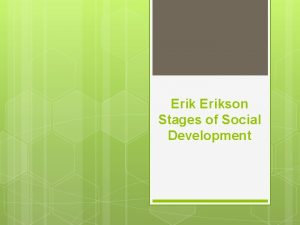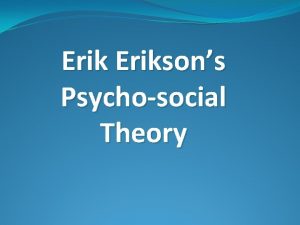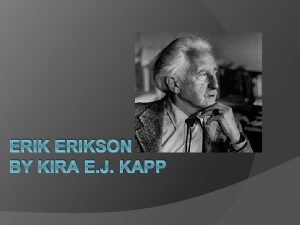Psycho social Stages of Development 8 stages Erikson














- Slides: 14

• Psycho social Stages of Development 8 stages: Erikson • Stage 1: (trust versus mistrust- Birth to about 18 Months): • The baby must learn to develop basic trust, failure lead to social withdrawal & depression. 1

• Stage 2: (Autonomy versus Shame and Doubt-18 Months to 3 Years): • Development of speech , sphincter and muscular control, if failed regression may results • Stage 3: (Initiative versus Guilt( 3 - 5 Years) : • Development of a superego locomotor and language skills expands, failure leads to guilt and anxiety 2

• Stage 4: (Industry versus Inferiority ( 5 -13 Years): - The child discovers the pleasures of production, if failed may develop a sense of inferiority and inadequacy. • Stage 5: (Identity versus Role Confusion(13 -21 Years): • The ability to leave home and live independently, Failure lead to inability to separate from the parent. 3

• Stage 6: Intimacy versus Isolation ( 21 - 40 Years): - Ability to make and commitments to affiliations and partnerships, failure lead to become deeply isolated • Stage 7: Generatively versus Stagnation (40 - Years): - Capacity to form intimate relationships with groups, organizations and society, failure lead to personal stagnation. 4

• Stage 8: Integrity versus Despair (about 60 Years to Death): - Acceptance of one's life and significant changes , or may have fear of death, despair and hopelessness. 5

The Dynamics of Motivations • Motivation: is an internal state that activates, guides behavior and directs it toward a goal. • focus on behavior (e. g. the thirsty person to drink, the person in pain to escape from the painful stimulus). 6

Factors affecting motivation: • 1 - Instinct: "an innate biological force that predisposes the person to act in a certain predictable way when stimulus is present ". - our thoughts and behavior are the result of instincts. -Some instincts include (curiosity – reproduction –construction). 7

2 - Needs and Drives: *need: represents physiological state of tissue as a result of lack of food, water, oxygen or avoidance of pain. *drive: “motivates the person to initiate behavior or action”. ** Drive refers to the psychological consequences of a need. 8

3 - Learning: - human motivations are learned. - People with high urge to achieve realistic and challenging goals, and persist longer and do better on difficult tasks. 9

Types of motivators: I. Hunger: - Powerful motivator, influence the feeling of hunger. - If you are accustomed to eat at certain times of a day, you will feel hungry at that times. II. Thirst : - Water deficit motivates the person to drink. 10

• III. Sex: - essential to the survival of species. • IV. Avoidance of pain: -The need to avoid tissue damage (fire) is essential to the survival of any organism. 11

Human Motivations and needs: - Maslow’s hierarchy of human needs: I. Self actualization II. Self esteem III. Belonging & love IV. Safety & security needs V. Physiological needs 12

Maslow’s hierarchy of needs 13

* The needs at one level must be at least partially satisfied before the next level become important determiners of action • When food and safety are difficult to obtain, satisfaction of these needs will dominate person’s action & higher motives have little significance • approximately 1% of people self-actualized. emotion 14
 Psycho social theory of development
Psycho social theory of development Erik erikson stages of development
Erik erikson stages of development Erikson adolescent stage
Erikson adolescent stage Erikson stages of development
Erikson stages of development Erikson stages of development
Erikson stages of development Social emotional development erikson
Social emotional development erikson Parlour scene psycho analysis
Parlour scene psycho analysis Freud 5 stages of development
Freud 5 stages of development Bio psycho sociale model
Bio psycho sociale model Psychospiritual example
Psychospiritual example Psychological thriller subgenre
Psychological thriller subgenre Artificial telepathy technology
Artificial telepathy technology Psycho oncologie
Psycho oncologie Tuckman model
Tuckman model Maslow stages of development
Maslow stages of development

